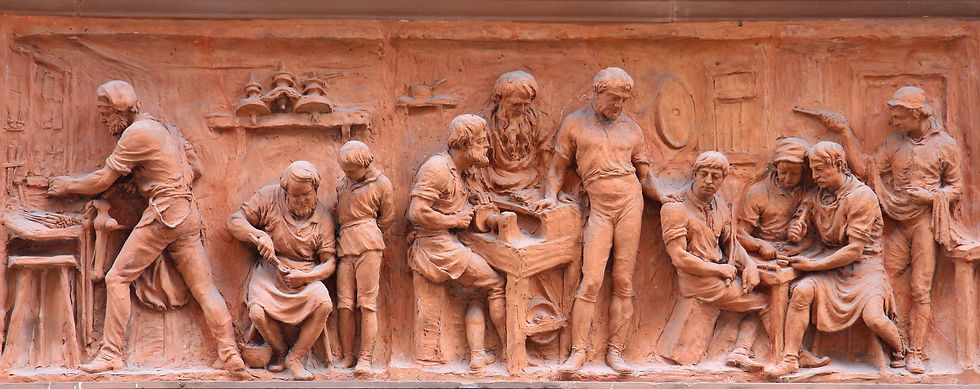The delicate terracotta Cutlers
- London On The Ground
- Aug 12, 2022
- 3 min read
An exquisitely shaped frieze depicting skilled craftsmen adorns a red brick Victorian building in the City of London.

The building is Cutlers' Hall on Warwick Lane, home to the Worshipful Company of Cutlers, one of the City's 110 livery companies. These are trade associations that emerged from trade guilds in medieval times. They were formed to protect and further the interests of members of the same trade or craft.
Walks available for booking
For a schedule of forthcoming London On The Ground guided walks, please click here.
The Cutlers' trade was the making and selling of knives, swords and other items with a blade. The Cutler's Company received its first Royal Charter under Henry V in 1416, a year after the king defeated the French army at the battle of Agincourt, but the first recorded mention of 'A House of the Cutlers' dates back to 1285.

The focus of their craft shifted from weapons of war to cutlery and other domestic utensils, including scissors and razors.
By the 16th century, the Cutlers' Company embraced not only bladesmiths (who made blades) and sheathes (who made scabbards and sheaths), but also related craftsmen such as gilders (who added decorative gold) and furbishers (who polished and finished blades) and grinders (who sharpened blades).
The Company still supports the making of swords, cutlery and surgical instruments through apprenticeships, education and philanthropy.
The Cutler's coat of arms, which can be seen above the door to its hall, depicts crossed swords and an elephant carrying a castle on its back. The elephant reflects the historical use of ivory in cutlery handles (a practice long discontinued).
The motto, 'Pour Parvenir A Bonne Foy', translates as 'To Succeed Through Good Faith'.

It is likely that the Elephant and Castle area in south London takes its name from a local inn displaying this sign that belonged to the Cutlers' Company.
Incidentally, the elephant and castle motif was also adopted by other organisations. These included the Royal African Company, whose main business was the trafficking of African people in the trans-Atlantic slave trade. However, there is no clear connection between this company and the Cutlers'.
The Cutlers' Company commissioned Benjamin Creswick (1853-1946) to create the terracotta frieze when the current hall was built in 1887.
Creswick grew up in Sheffield, the historic home of the cutlery trade, and was briefly apprenticed to a knife-grinder until illness cut short this career path. His doctor encouraged him to take up sculpture after he had made a terracotta bust of John Ruskin, a writer, artist, art critic and philosopher, who became Creswick's supporter and mentor.
As the Cutlers' frieze so vividly demonstrates, Creswick had a real flair for sculpture.

In total the frieze has 33 figures in four panels showing the four main facets of the cutlers' craft: forging, grinding, hafting (preparing and fitting knife handles) and finishing.
Panel 1: Forging

Left to right: plunging hot scissors into the hardening trough; forging scissors; heating the iron and hardening table knives at the bellows; the maker or 'smith' and the 'striker' (both with hammers) forging table knives; bringing a bundle of steel into the smithy.
Panel 2: Grinding

Left to right: carrying a box of finished knife blades; a seated old man polishing or 'buffing' blades; glazing the blades and checking the stone marks have gone; hewing the grindstone; grinding the grindstone; setting blades before they are put on the grindstone, while a man holding a small grindstone remonstrates with him; an apprentice carrying a box of new work on his shoulder; two men carrying a large grindstone.
Panel 3: Hafting

Left to right: filing a handle at the workbench; filling handles with compound as a young boy looks on, having brought his father's dinner; a seated figure polishing a knife handle or 'dollying'; a bearded man filing a handle; a standing man advising a seated apprentice drilling holes in handles; a seated youth scraping or 'shaving' knife handles with a piece of flat steel; a seated moustachioed man riveting handles; wiping off and checking the work.
Panel 4: Finishing

Left to right: grouping scissors into lots; a man reaching for tongs and blowing the bellows; a little boy poking the fire; boring the scissors on the foot-operated lathe; glazing the scissors; the scissor filer; finishing off and testing the scissors.
Fortunately, Cutlers' Hall - and Benjamin Creswick's exceptional frieze - survived the aerial bombings of World War II, as did the nearby St Paul's Cathedral.
The sensitively moulded terracotta cutlers are the only detailed depiction of all the stages of a craft or trade that is publicly visible on a City livery hall, but they are far less well known than the Cathedral. Nevertheless, the frieze is well worth a visit, particularly to see my favourite pair of figures: the boy absorbed by his father's careful work.

Walks available for booking
For a schedule of forthcoming London On The Ground guided walks, please click here.

Lovely! And I agree, the little boy watching his father work is so charming!
Thanks Jonathan, this is fascinating. Such a fabulous frieze - how has it escaped my attention! Much appreciated, Will
It's around the corner from St Paul's. Warwick Lane runs north-south between Newgate Street and Ludgate Hill. Thank you for your comment!
That's amazing! I briefly thought it might be the old Doulton building in Lambeth - but that isn't the City of London of course. I'll look out for this.